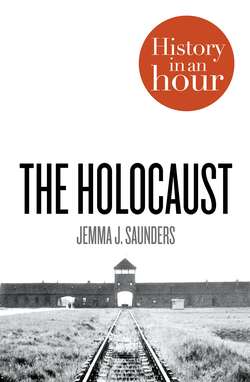Читать книгу The Holocaust: History in an Hour - Jemma Saunders J. - Страница 14
Ghettoization
ОглавлениеThe internment of Polish Jews in ghettos began in the autumn of 1939. While some ghettos were open, permitting residents to move beyond the boundaries when a curfew was not in place, the majority were closed, with high walls, barbed wire and armed soldiers preventing anyone from leaving. As the Nazi campaign against the Jews twisted towards a policy of annihilation, many ghettos that had previously been open were sealed.
The Warsaw ghetto became the largest in Poland, where 400,000 Jews were crammed into an area of just 1.36 square miles. Such overcrowding was a common feature of ghetto life and several generations of multiple families often lived in one small room, with minimal furnishings.
As fighting continued across Europe, resources in the ghettos became scarce. The official food rations constituted barely 300 calories of sustenance per day, and severe malnourishment or death from starvation was commonplace. Children often foraged beyond the ghetto confines at night for supplies, as they were less likely to be caught than adults. Some used the sewers as a discreet means of moving from one area to another, in search of bread, medicine or weapons. Overcrowding and a lack of basic amenities resulted in filthy conditions both in houses and on the ghetto streets, which in turn led to the inevitable spread of lice and diseases such as typhus.
The Nazis ordered the establishment of Jewish Councils to act as administrative bodies within the ghettos. These Judenräte were usually formed of prominent community figures, often elders, through whom the Nazis disseminated their rules and orders. Demands were habitually made on the Judenräte which had to be met or the consequences would be swift and severe. If the SS ordered that 1,000 gold wedding rings should be handed over by the next day, 1,000 rings would have to be sourced and delivered within the timeframe granted. Refusal to comply could result in death, but collusion with the Nazis at any level weighed heavily on individual consciences. Indeed, some Jewish leaders, such as Adam Czerniakow, committed suicide when asked to compile deportation lists, rather than initiate actions that would send thousands of their compatriots to almost certain death.
Rutka Laskier lived in the Bedzin ghetto and wrote of the horrors she witnessed under the Nazi occupation in her diary, including seeing a German soldier brutally kill a Jewish child. Like many ghetto Jews, Rutka worked for low wages in a local factory. Employment was a fragile safety net, as any Jew deemed ‘unproductive’ was at even greater risk of maltreatment. Aged just 14 when her family was moved from Bedzin’s open ghetto to the closed Kamionka ghetto, Rutka was nevertheless later deported.
Specially commissioned propaganda films and imagery of ghetto life strove to depict Jews as living comfortably in the areas where they has been ‘resettled’. In reality, conditions were cramped, unsanitary and demoralizing. Theresienstadt, in Czechoslovakia, was portrayed as a model ghetto where elderly Jews and Jewish war veterans were sent to retire. In truth, this was another Nazi deception and an estimated 33,000 people still perished there during the war. Like the majority of ghettos in which Jews were interned, Theresienstadt was, for most who were sent there, either their final destination or the penultimate stop on a road to slave labour and death.
